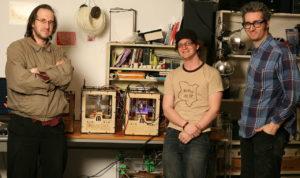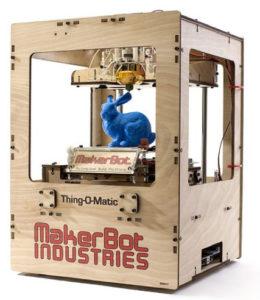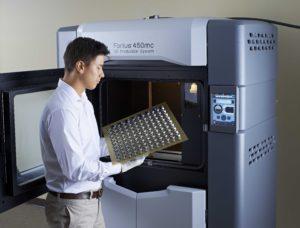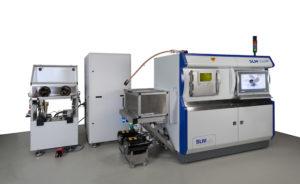CEO & CFO Replacements at Stratasys, MakerBot & SLM Solutions: Why All the Executive-Level Shakeups in 3D Printing?
The 3D printing market has seen a lot of growth, development and commotion of the past months. With growth spurts come growing pains. Over the past four weeks we’ve seen Stratasys CFO Erez Simha, SLM Solutions CEO Markus Rechlin and MakerBot’s CEO Jonathan Jaglom all leave. Why the sudden spate of C-level executives leaving large 3D printing companies?
The 3D Printing Hype
As our industry continues to mature, executing on corporate strategy is becoming increasingly difficult for some established players. In the Hype Years of 2008 to 2016 it was full steam ahead for the entire industry. Almost anything your marketing department did would get picked up by media, news reports around 3D printing were almost continuous and life was simple. Corporations and startups alike basked in the media attention and grew quickly. Tens of thousands of new customers bought printers as companies the world over took an interest in 3D printing. With very little established knowledge of 3D printing available in the market, whatever your R&D department cooked up would sell. There were plenty of customers for everybody. There was no real need to differentiate your product or work hard in sales or product development. For much of the Hype period many companies’ biggest problem was figuring out how to make enough machines to fulfill demand. Many startups were doubling year on year or growing by 30% per month. Two-person teams became companies with 100 or more employees in less than a year.
The 3D Printing Hangover
Now we have a much more mature market. The landscape is dotted with 3D printer startups and new market entrants. Potential customers have more knowledge, but also much more choice. The plethora of competing 3D printing companies is leading to a period of hesitation. Many companies have bought their first printers and are now evaluating them. Some are disappointed with the technology or the devices that they’ve bought. Others are moving to integrate 3D printing more in their production or product development process. To buy a 3D printer to play with is easy but to industrialize the technology is very difficult. Certification, dialing in materials, reducing error rates and quality control are just some of the problems these companies are facing. Moreover they often do not have the requisite skills to industrialize a 3D printing process in house. This is one of the reasons why Stratasys and EOS for example both have consulting services that they offer to customers. Their consultants are needed in order to help customers design for 3D printing and set up things such as quality control. The flood of customers has receded but those that are interested now are looking at integrating 3D printing in their product development process or producing end-use parts with 3D printing. The level of investment and commitment needed takes time. This is causing large deals and implementations to lag behind expectations. Large deals are often delayed or don’t come to pass. This is wreaking havoc with people’s sales numbers. This in turn makes future revenues difficult to predict and seem uneven. That makes investors and shareholders nervous. What most probably happened at SLM, MakerBot and Stratasys was that given the unpredictability of new large 3D printer implementations each executive was not able to with sufficient accuracy estimate revenue properly.
Desktop 3D Printers Are Bought by Companies
In 2011 thousands of Business Development Managers bought desktop and industrial 3D printers to play with them. Now we’ve got compliance teams pricking holes in 3D printer performance. Startups often came to market making machines for Makers. They’re only now beginning to find out that approximately 75% of desktop machines are actually being bought by companies. These companies want more reliability, better tolerances, lower part cost, easier maintenance, higher throughput and a whole host of things that desktop 3D printers currently do not have. Desktop 3D printer OEMs seem completely caught off guard by clients trying to use their machines to manufacture parts. It will take time for them to upgrade their machines sufficiently and implement better software and things such as print farms.
MakerBot
Despite all the media talk of “everyone being able to use 3D printers to make anything” the reality was rather more sobering and disappointing. Amidst claims of large multinationals adopting 3D printers throughout their engineering departments the performance of desktop machines was inadequate. Most desktop machines had failure rates of 50% or higher. 50% or greater of all prints started failed. It sometimes took more than twenty minutes to replace a blocked nozzle. Low-cost parts such as fans broke regularly and machine reliability was terribly low. We also collectively forgot to tell the media that 3D printing is very very slow. MakerBot was selling people a dream of a microwave for stuff. Meanwhile in the real world, getting a 3D printer to actually print was a tough slog. Amidst this a focus on growth meant that a lack of attention was paid to quality and engineering. MakerBot developed quality control issues. Units were arriving to customers dead on arrival and faith evaporated. Simultaneously a backlash against MakerBot was ongoing in the open source 3D printing community. MakerBot’s decision forgo open source led to many overnight turning from fanboys to harsh critics. The company had over time fired key people in engineering at a rapid pace. This meant that it did not institutionalize learning key lessons in 3D printer development. The company’s Smart Extruder was a dud sometimes only lasting 20 hours and with 80% of the units returned to the company. Coupled with employee discontentment and increased competition, MakerBot was in freefall.
Jaglom the Parachutist
Jonathan Jaglom was parachuted in to fix all of these problems. A former marketing and sales manager at Stratasys, he had been responsible for Stratasys’ Asian business. He also developed Stratasys’ channel partners helping build its reseller network and running customer support. In the company he’d tackled difficult issues before, now he was tasked in saving MakerBot. He reorganized the company, brought back quality control and better manufacturing practices. Ambitions and headcount were downsized but the 3D printers got better. He outsourced production to contract manufacturer Jabil and reorganized the company. Now MakerBot is healthier and once again on a solid path forward. Parent company Stratasys however still needed MakerBot to be successful. MakerBot’s shift in focus towards education and businesses was good but the unit still had to contribute to earnings. Revenue at MakerBot was still down by more than 50%. This probably led to Jaglom, even though he saved the business, being replaced (along with the stated reason to spend time with family). Now the unit can focus on growth and maybe contributing to earnings at one point.
Stratasys
Stratasys has consistently written down the book value of MakerBot. The goodwill impairment charges they’ve taken on MakerBot are now higher than the purchase price of the company. Stratasys CFO Erez Simha’s abrupt departure has been hastened in part by this. The former Orbotech CFO had been with Stratasys since 2011. Simha was one of the key architects of the Objet and Stratasys merger. Many were surprised when the much smaller Objet did a reverse takeover of Stratasys. Former Objet staffers then took key positions in management. Under former CEO David Reis the company started to move aggressively forward. As well as the MakerBot acquisition Stratasys then acquired Solid Concepts and Harvest. Solid Concepts cost $295 million and brought one of the world’s largest 3D printing service bureaus to the fold. Another large service bureau, Harvest Technologies was acquired for $27 million in stock. Both Solid Concepts and Harvest Technologies were some of the most experienced 3D printing companies in producing end-use parts. In addition to revenue from machines Stratasys was now strengthening its RedEye 3D printing service business and becoming one of the largest 3D printing service bureaus worldwide. Revenue from services was robust and let the company grow. MakerBot revenue did not grow apace with expectations, however. The company missed revenue targets and disappointed shareholders. Reaching highs of $136 in 2014 Stratasys shares are now just shy of $20. The aggressive high growth strategy deployed by the Objet team seems to have fallen short of expectations. The ‘consumer 3D printing revolution’ simply did not happen in an expected way. Meanwhile industrial 3D printing adoption was slow since companies had so much that they needed to learn. Revenue growth at the company seemed to stagnate in numerous areas. This disconnect between expectations precipitated Simha’s leaving of Stratasys.
SLM Solutions
SLM Solutions was a smaller player in the 3D printing metals market. The German company was generally behind EOS, Concept Laser and Arcam in prominence and revenue. EOS GmbH is the market leader in plastic selective laser sintering machines and the market leader in metal 3D printers (although as of this year the leader may become GE). The metal 3D printing market was a rather tiny clubby affair of small companies selling maybe 100 or so machines a year to universities, dental companies, orthopedics manufacturers and some aerospace companies. When in 2012 GE acquired Morris Technologies the industry was in awe of the technology giant’s interest in 3D printing. GE took approximately a quarter of all 3D printing service bureau capacity offline, reserving it for themselves. Service bureaus and the OEMs that made the machines were awash with orders. Companies could not produce enough machines and were met with increasing numbers of new customers attracted by the 3D printing hype. Increased government funding in China and the US in metal 3D printing for aerospace also increased orders. SLM Solutions looked like a laggard at first. Their print quality increased considerably though and their larger systems such as the SLM 50 were just what the market was looking for.
Turbine Blades
Whereas previously only orthopedics and dental companies had been doing large-scale production of end-use parts, now it was the aerospace industry that wanted to industrialize manufacturing with metal 3D printing. Existing machines were very much “lab machines” with lots of settings and customization but low throughput. These new customers wanted automated depowdering and finishing steps, quicker builds and more efficiency. They were looking for quality assurance and testing procedures. The first few generations of machines would have to be radically improved to meet these new customers’ demands. They wanted much larger manufacturing machines. SLM Solutions, along with help from investor Parcom and an IPO, was able to obtain the money to make the right investments building ever larger machines and making a quad laser technology available to increase throughput.
Markus Rechlin
The company posted impressive numbers with revenue growing from 11.9 million in 2011 to 66.1 million in 2015. Gross profit went from 5.9 to 36 million over the same period. Those seem like very impressive numbers. So why the sudden departure of CEO Markus Rechlin? He’d been with the company for years and his performance seemed stellar. Speculation initially was that shareholders such as Parcom or Management Board member Henner Schöneborn were upset that GE’s $703 million acquisition of SLM did not go as planned. The anchor shareholders such as Parcom and Mr. Schöneborn (and his sons) had agreed to sell their shares to GE and were happy with the 38 Euro acquisition price. Investor Elliott Management, however, was not and wanted to negotiate for more. GE balked and walked away from the deal, buying Concept Laser instead.
We reached out to SLM Solutions to find out more and a spokesperson told 3DPrint.com that, “the change of personnel was not connected to the failed takeover attempt by GE in 2016 in any way.” This is rather puzzling. SLM Solutions announced that it “removed the CEO with immediate effect.” Although he is being replaced temporarily by CFO Uwe Bögershausen, no replacement was found in advance. Additionally there was no cuddly language about “wanting to spend more time with his family.” Just a straightforward announcement that the board took the, “decision today to remove Dr. Markus Rechlin from his position as CEO and from the Management Board of SLM Solutions Group AG.” The board also, “thanks Dr. Rechlin for his many years of dedicated and committed contribution to the company.”
The company did miss expectations in the last quarter of 2016. Revenue was expected to be “EUR 75 million to EUR 80 million (previously: EUR 85 million to EUR 90 million).” Was that enough for Dr. Rechlin’s sudden ouster? Perhaps. Given Uwe Bögershausen’s degree of power as a leading shareholder and management board member a simple falling out between these two could have brought along something similar.
If we look at SLM Solution’s competitive position in 2016 the company was sitting pretty. EOS was larger and competing directly with it in increasing the automation and size of the metal 3D printers. Arcam was doing well with its own technology and Concept Laser was smaller but growing. Each of these companies knew that GE would at one point most probably acquire one or more of the others. Now in 2017 we know that GE has Arcam and Concept. It will buy hundreds or perhaps thousands of its own metal 3D printers. The industry giant has committed itself publicly to industrializing metal 3D printing for aerospace. EOS continues to do well and new competitors such as Additive Industries are starting to make their presence felt on the market. The once clubby industry is starting to feel a little lonely for the people at SLM Solutions. If GE makes inroads in saving considerable weight on aero engines by using 3D printing a response by other engine manufacturers is likely. Surely they will as GE see that the quickest path to market and surest way to industrialize in metal would be to acquire a metal OEM. There will be other opportunities for SLM to sell itself should it wish. The path forward for SLM as an independent company looks more complicated however. To industrialize metal machines that can compete with EOS and GE’s offering in reliability, repeatability, QA, throughput and automation will require significant investments. Perhaps after not getting the team the exit that they wanted and missed expectations, it was in that area that Dr. Rechlin did not succeed? SLM needs a partner or considerable new financing to compete in a race with privately held EOS and the very public GE. Without selling itself it will have to take on debt or find another way of financing itself. Missing expectations while seeking additional funds could be a herculean task. Not succeeding at this is the most likely reason for Dr. Rechlin to leave so suddenly.
Industrializing 3D Printing Is Hard
To take a completely new (to you) manufacturing technology and implement it in an industrial setting with good output requires time and money. Deals and implementations of this kind will be large but chunky. These types of engagements are costly, time consuming and may be delayed. This is causing revenue numbers of companies in industrial 3D printing to be uneven and less predictable than people would like. Missed promises as a result of this, most probably, led to the sudden leaving of Markus Rechlin at SLM Solutions, Erez Simha at Stratasys and Jonathan Jaglom at MakerBot.
Let us know what you think about these shakeups in the 3D Printing Executives forum at 3DPB.com.
Subscribe to Our Email Newsletter
Stay up-to-date on all the latest news from the 3D printing industry and receive information and offers from third party vendors.
Print Services
Upload your 3D Models and get them printed quickly and efficiently.
You May Also Like
Metal Powder Supplier Elementum 3D Added to $46B Air Force Contract
Elementum 3D, a Colorado-based developer and supplier of metal powders used in additive manufacturing (AM), announced that the company has been added to the vendors list in the fourth on-ramp...
Ursa Major Lands $28.6M AFRL Deal for 3D Printed Draper Engine Flight Demo
The US Air Force Research Laboratory’s (AFRL’s) Rocket Propulsion Division at Edwards Air Force Base has awarded a $28.6 million contract to Ursa Major for follow-on work related to the...
3D Printing Financials: Rocket Lab’s Record-Breaking Year and Over 20 Launches Coming in 2025
Rocket Lab (Nasdaq: RKLB) closed 2024 with its best year yet. The company launched more rockets, signed more contracts, and expanded deeper into spacecraft and satellite production than ever before....
US Air Force Taps Beehive to Study 3D Printed Jet Engines
Propulsion 3D printing firm Beehive Industries secured a contract from the U.S. Air Force Life Cycle Management Center through SOSSEC. SOSSEC is a company that manages Other Transactions Authority (OTA)...





































